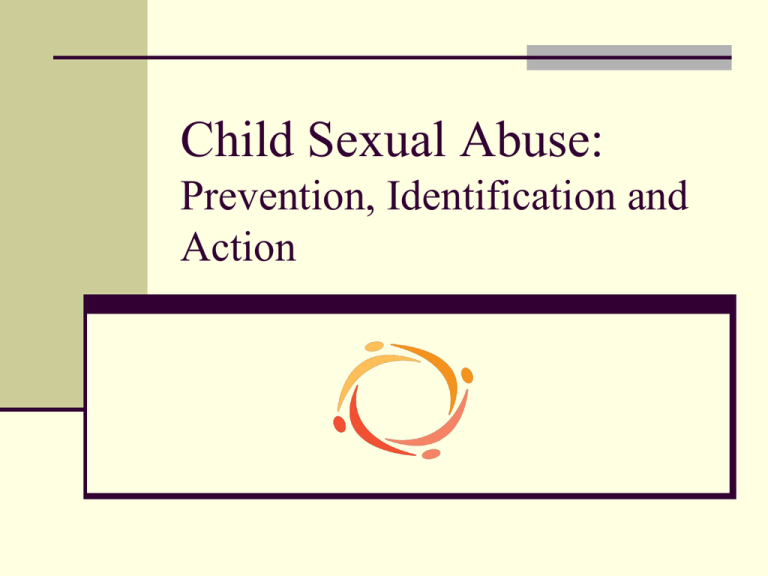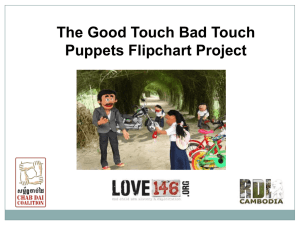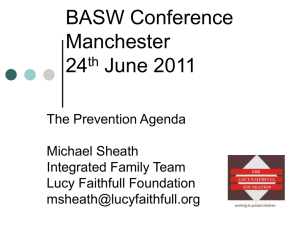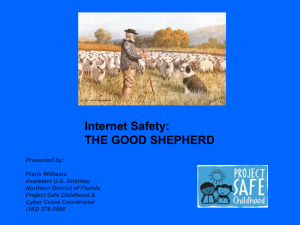
Child Sexual Abuse:
Prevention, Identification and
Action
Agenda
What is child sexual abuse (CSA)
Dynamics of CSA
How children experience CSA
Perpetrator risks and dynamics
Cultural considerations
Responding
What is CSA?
Any interaction when the child is being used
for sexual stimulation of the child or the
perpetrator or observer.
Contact sexual abuse
Non-contact sexual abuse
Care and/or custody of the child (CPS)
Sexual Assault/Statutory Rape
Sexual Assault:
Assault of a sexual nature or sexual act without
consent.
Statutory Rape:
Sexual activity where the child is below the legal age of
consent.
Different term, age differentials and particulars for
charging across states.
http://aspe.hhs.gov/hsp/08/sr/statelaws/summary.shtml
Sexual Trafficking
Child sex trafficking includes any child
involved in commercial sex (Polaris Project)
Florida, Illinois, Connecticut and Maryland
State regulations governing Social Services
Departments to provide services to victims of
Human Sex Trafficking
Check with your local jurisdictions about
mandated reporting.
CSA History
Exploded into awareness in the 1980s.
322% increase in reports (National Center on
Child Abuse and Neglect, 1988).
Credibility of reports questioned.
Complaints of false allegations and brainwashing.
Nationwide agencies develop methods and
protocols for investigating CSA allegations.
Dynamics of CSA
Unique crime with unique behaviors and
dynamics
Rarely third-party witness or medical
evidence
Only 4-5% of children who give a credible
history of sexual abuse have a specific finding
on medical exam.
94-95% of all children who give a history of
sexual abuse have a normal or nonspecific
medical exam.
Dynamics of CSA: Myths
Denials of the extent of CSA
Perpetrator stereotypes
Minimizations or exaggerations of the extent of
harm CSA poses on the child
Diffusions of perpetrator blame
Extent of CSA: How common is it?
High incidence and prevalence
1 in 4 girls
1 in 6 to 7 boys
…Will be sexually abused before the
age of 18.
Elevated risk for younger children and
children with disabilities.
Extent of CSA: How common is it?
300,000 cases reported in United States
Only reported cases; unknown how many
cases actually exist
Only
10% of children report their abuse
Extent of CSA: How common is it?
Myth:
Only happens in poor, uneducated
communities…
Fact:
Inconsistent and scarce findings that race or
socioeconomic status are risks
Unlike physical abuse
Perpetrator Stereotypes
Myths
Stranger danger
Media focus
All CSA perpetrators are male
Dirty, perverted men
Men who sexual abuse boys are homosexual
Perpetrator Stereotypes
70-90% of alleged abusers are people the
child knows and trusts
90% of alleged offenders are male; however,
there are documented cases of female
perpetrators
Highly under-reported and not recognized
CSA alleged offenders tend to be married,
employed and heterosexual
How Children Experience Abuse
Child Sexual Abuse Accommodation
Syndrome (CSAAS)
Roland C. Summit, M.D. (1983)
Widely known theory for understanding
dynamics of child sexual victimization
However, merely a clinical opinion, not
scientific instrument
Anecdotal, not backed by research
Child Sexual Abuse Accommodation
Syndrome (CSAAS)
Five categories:
Secrecy
Helplessness
Entrapment and Accommodation
Delayed, unconvincing disclosure
Retraction and Recantation
Secrecy
Happens when child is alone with their
abuser.
“This is our secret.”
“Don’t tell anyone, or else.”
“Nobody will believe you.”
Both the source of fear and the promise of
safety.
Helplessness
Authoritarian relationship
No child has equal power to say no to a parental figure
or to anticipate the consequences of sexual
involvement with an adult caretaker.
Expectation for child to cry out and run away
Almost every child fails.
Fight, flight, freeze.
Difficult for courts and law-enforcement to understand
Disbelief and rejection by non-offending caregiver =
self-blame, self-hate, guilt for allowing the acts to
occur.
Entrapment and Accommodation
Abuse is not usually a one-time occurrence.
Multiple incidents
Grooming
Accommodating to escalating sexual
demands.
Child faced with continued helpless victimization
must learn to somehow achieve a sense of
power and control.
Child prepares for the sexual act before it happens:
Undresses and places themselves in a position for their
perpetrator.
Child initiates the sexual act.
How Children Experience Abuse
Usually happens under the disguise of love or
attention:
Bath time
Bedtime
While watching TV on the couch
Wresting and tickling
Games
Abusers use these and physical contact
opportunities to sexually touch children.
Natural reactions of healthy child to profoundly
unnatural and unhealthy caregiver environment.
Coach on your soccer team always tells you what a
great job you’re doing on the field; he couldn’t get
along without you; if he had his way, you’d be voted
most valuable player. Everyone loves coach, so it
makes you feel good that you have his attention.
Then while he’s driving you home, he starts saying
things like how during showers he noticed you were
really developing into a man. He begins commenting
on the size of your penis and how some day you’re
going to make a girl really happy. All of a sudden the
good feeling goes away and you feel embarrassed,
confused, maybe frightened.
How Children Experience Abuse
Is this really abuse?
Confusing emotions:
Ordinary, non-sexual interactions when not
being abused.
Way the community views the abuser – good
citizen.
He didn’t mean it – It must have been an
accident.
Victim thinks he/she is weird for having a bad
reaction to what happened.
How Children Experience Abuse
This must be love
Grooming – abuse is concealed by love and
attention
Kids respond to loving attention. Like to have people
spend time with them, give them treats and make
them feel loved.
Some kids enjoy the physical closeness and physical
feelings that can happen in the abuse situation.
They seek out the abuser for attention.
How Children Experience Abuse
“It felt good to me and I wanted it.”
15y/o abused by older brother
“It was my mom’s boyfriend and he treated
me like his girlfriend – holding my hand when
we went to the mall, telling me I was so goodlooking. I felt special.”
14y/o abused by mother’s boyfriend
“I liked it in a way. I kind of felt loved. He’d
always be there for me.”
16y/o abused by biological father
How Children Experience Abuse
I deserve this.
Perpetrator tell you, “you seduced me.”
Adults are never do wrong.
How Children Experience Abuse:
Disclosure and Discovery
Accidental vs. Purposeful Disclosure
Majority of cases are accidental discovery
(74%)
More likely in pre-schoolers
Sexualized behavior or inappropriate statements
Exposure to an alleged suspect
Share with a friend who did not keep the secret
Child has Sexually Transmitted Infection
Child is pregnant
How Children Experience Abuse:
Disclosure and Discovery
Purposeful disclosure:
Educational awareness (school prevention
programs)
Influence of peers (predominantly young
teens)
Proximity to perpetrator
Departure of perpetrator or threat of return of
perpetrator
Timely disclosure
Anger (adolescent group)
How Children Experience Abuse:
Disclosure and Discovery
Disclosure is a process not and event.
Most on-going sexual abuse is never
disclosed (retrospective adult studies) or
there is a significant time lag between abuse
and disclosure.
Most adults delayed disclosure or failed to
disclose in childhood
55-69% of adults never told
Treated, reported or investigated cases are
the exception, not the norm.
How Children Experience Abuse:
Disclosure and Discovery
“Nobody would believe me.”
“I would never tell. This would kill my
mother.”
“Not a chance! They would put me in some
foster home or take me away from my family.”
“If I tell, I’d have to go to court and then
everyone would know about it.”
How Children Experience Abuse:
Disclosure and Discovery
116 confirmed cases (Sorenson & Snow, 1991)
Denial
3/4th of children denied having been sexually abused
Active Disclosure - Personal admission by the child
Only 7% that initially denied, then moved into active
disclosure.
Only 11% were able to provide a disclosure without denying
or demonstrating tentative features.
Tentative Disclosure - Partial, vague or vacillating
78% - common middle step from denial to active disclosure
“I forgot”
“It happened a long time ago”
“He tried to touch me, but I hit him and ran away”
How Children Experience Abuse:
Disclosure and Discovery
Delayed disclosure risks:
Some data indicate that males are more
reluctant to disclose than females
Younger children may not have linguistic or
cognitive abilities
Relationship to perpetrator: longer delays
among familial
Support from non-offending caregiver
(protective factor)
How Children Experience Abuse:
Disclosure and Discovery
Disclosure does not always mean safety for the child.
Majority of offenders have kinship and trusted
relationship; therefore, child is put on defensive for
attacking credibility of a trusted adult.
Risks of family separation.
Threats from the alleged offender for telling.
Disbelief from authorities and non-offending caregivers
Delinquent/acting-out child
Well-adjusted child
Child does well in school and all other social aspects – not
showing any kind of distress; how could the allegations be
true?
How Children Experience Abuse:
Recantation
Retraction of a previous allegation of abuse
that was formally made and maintained.
Pressure/threats from perpetrator
Pressure from family, coaching
Disbelief
Fragmentation of family (child bears
responsibility)
Negative personal consequences
Investigative process
How Children Experience Abuse:
Recantation
Percentage rates vary across studies from
high to low numbers:
23.1% recantation rate
(Malloy, L.S., Lyon, T.D., & Quas, J.A; 2007)
Abuse victims more vulnerable to familial
adult influences
Young children
Abuse by parent figure
Lack of support by non-offending caregiver
Maternal reactions are protective factor
How Children Experience Abuse:
Reaffirmation
Reaffirmation:
Reassertion of the validity of a previous
statement of CSA.
Of those recanted, 92% reaffirmed their abuse
over time.
Disclosure is a process.
False Allegations
“Why didn’t my child tell me sooner?”
If child was really being harmed, would have spoken
up.
When child is frozen in fear and does not fight back.
Viewed as consensual.
Child was angry for being punished.
Child has delinquency and/or mental health issues.
Promiscuous adolescent.
Diffusion of blame from perpetrator to child.
False Allegations
Majority of investigated accusations prove
valid.
Based on review of studies, only 4-8% of
allegations were fabricated.
Sloppy assessments could lead to false
positives or false negatives
Need researched-based investigative
protocols
Emotional Coping Techniques
Avoidance:
“As soon as”…
the abuse stops, I will be fine.
I go to college, everything will be different.
she finds a new husband, everything will be back to normal.
Minimizing:
“It’s not that bad”…
Lots of kids have it worse.
He didn’t mean it, he was drunk.
Denial:
“It happened, but I’m fine. No big deal.”
Forgetting:
Helps on surface, but deeper level impact.
Emotional Coping Techniques
Splitting/Dissociation:
Out of body experience
“I was about nine or ten; my father and I were driving in
the car. I can’t remember what he said to me or did
to me, but I was definitely not in my body. I mean,
my whole visual memory is of the back of his head,
the back of my head, the back of the front seat of the
car and that’s because I was literally on the ceiling at
the back of the car. So all I can remember is how
things looked from the back seat – but my body was
in the front seat!”
- Richie, 15y/o abused by biological father
Emotional Coping Techniques
Olga Trujillo: The Sum of My Parts
Dissociation
“Dissociating is like watching your life from 50 feet off the
ground” – Olga Trujillo
“The problem was, I dissociated automatically and had been
doing so for decades. It seemed like I couldn’t stop and I wasn’t
sure I wanted to. I liked feeling numb and calm. The fuzziness
in my head felt addictive.” – Olga Trujillo
“DID, or Dissociative Identity Disorder, is a separated sense of
consciousness. Consider it like a spectrum, with normal
dissociation one on end. On the other end is a fractured
consciousness with distinct personality states that are not
aware of each other: a condition formerly known as multiple
personality disorder, or MPD.”
Physical Coping Techniques
Eating Disorders
Drugs and Alcohol
Self-Mutilation
Sexual promiscuity (self abuse)
Suicide
Being Perfect
Psychological and Medical Impacts
HOWEVER: Some survivors do not exhibit
any negative consequences associated with
the abuse.
Positively correlated to satisfaction in current
social roles and one’s community.
Negatively correlated to additional trauma
exposure.
Myths on how a victim should react.
Sexual Behavior Problems
Do all children that have been sexually
abused act out sexually?
Belief that all sexually abused children will
have significant, long-term problems is not
supported by research.
Kaufman and Zigler (1987) – 70% of abused
children did not offend in adulthood
Widom and Ames (1994) – childhood sexual
abuse did not account for increased risks for
violent sex crimes.
Sexual Behavior Problems
Do all sexual behavior problems in children indicate
that the child has been sexually abused?
Myth in 1980s and 1990s
There may be other psychosocial difficulties causing
the child to display sexualized behaviors.
Physical abuse, neglect, family violence, etc.
However, suspicion of exposure in children who
display age-inappropriate sexual behaviors.
May be exposed to unhealthy sexual, emotional and
physical boundaries in the home environment.
Sexual Behavior Problems
Sexual exploration and sexual play are a
natural component of children’s development.
Similar age, size and developmental status
Voluntary basis
Light-hearted and spontaneous
Embarrassment, but no shame, guilt or fear
Child’s interest in sex and sexuality is
balanced by curiosity about other aspects of
his or her life.
Sexual Behavior Problems
Continuum:
Natural/healthy → Molestation of other children
Sexual Behavior Problems:
Sexually Reactive
Confusion about sex – trying to work through their
confusion by enacting behaviors
Extensive, Mutual Sexual Behavior
Sexual behaviors as a way of coping with feelings of
abandonment, loss and fear
Molestation of Other Children
Use some type of coercion.
Sexual Behavior Problems
How should we react?
Remain non-judgmental and non-punitive
Caregiver’s reactions influence child’s sexual
self-esteem, sexual identity and sexual
judgment.
Often becomes main focus for caregivers –
forget to look at child’s positive behaviors.
Do not discuss act as “sexual” with children.
Address the actual behavior
“Touching your penis”
Sexual Behavior Problems
Children who molest should not be compared
to adults who sexually offend.
Adult sex offenders have established sexual
arousal problems.
Pedophilic offenders’ primary sexual attraction
is to children.
Most children who molest are acting out their
hurt and angry feelings in a disorganized and
chaotic manner using sex as a vehicle.
Sexual behaviors in children do not represent
sexual gratification.
Sexual Behavior Problems: Sibling
Sexual Offending
Most common form of familial sexual abuse
Pervasive underreporting
Approximately half of all adolescent-perpetrated
offenses involve a sibling.
Correlated with family violence and dysfunction
histories
Sexual abuse, domestic violence history and exposure
to pornography
Implications for juvenile justice and mental health.
Family-based interventions
Creating Healthy Sexual Environment
Children with sexual behavioral problems may need to be supervised while with
other children.
Should not sleep in same bed with other children or adults
Child who molests should not sleep in the same room with any other children.
Overwhelming memories or encourage unhealthy sexual behavior
Other children in the home should know about the sexual behavioral problems
for the child with a history of molesting. Child with sexual problems should be
made aware that, for everyone’s safety, it is important for everyone to know.
Motion detectors
Should not be left to care for other children, even for a short time.
All bathroom activities should be done separately.
Children and adults should not walk around without clothes on.
Over-stimulating for child
Family meeting
Clinician’s role
Work with molesting child
Ask other children, in private, on a regular basis if other child has tried to touch
them (older children only).
Sexual Abuse Offenders
Does not excuse the abuser. Abuser is fully
responsible for the abuse.
Fixated Offenders
Sexual attraction toward children (pedophilia)
Regressed Offenders
Abuses children within easy reach – stressors
Turns to child in misguided attempt to cope
Children give affection freely, idolize parents,
taught they cannot say no to a parent.
Sexual Abuse Offenders: Why do they
abuse?
Abused themselves as children
Lack abilities to relate to people, express love and affection,
express anger and disappointment.
Trying to feel loved and important
Feeling intimate with children makes them feel secure.
Looking for power and control
Not looking for love or sexual pleasure, but satisfaction of
being in control of another.
Think love and sex are synonymous
When child shows affection, think child is looking for sex. In
turn, they think they are showing affection by being sexual.
Acting out their rage
Take pleasure in seeing children hurt and in pain.
Was a victim, but instead of becoming a survivor, became an
abuser.
Cultural and Ethnic Considerations
No culture is defined solely by one value, nor
is any particular value held by one culture
exclusively.
Be culturally competent, but avoid
stereotyping.
Cultural background appear most associated
with psychological symptoms.
Cultural and Ethnic Considerations
Correlation between
acculturation level and
reporting.
Knowledge of legal systems
Immigration fears
Shame
Predictor of post-abuse
adjustment
Honor, respect and
patriarchy
Asian cultures
Familism (family harmony and
stoicism)
Filial piety (honoring older
male relatives)
Taboos and Modesty
Sexual discussion and
education taboos
Religious
Sexual Scripts
Male-female interaction
Gender struggle model
Virginity
Less valuable brides
Loss of prestige for the
family or disgrace (Honor
Killings)
Virginity tests
Obligatory violence
Retaliation by family
members (child may delay
disclosing to protect family)
Responding
Acceptance and validation are crucial to the
psychological survival of the victim.
Mothers typically react to allegations with disbelief
and protective denial.
How could I not have known?
Why didn’t my child tell me sooner?
How could my husband, who I’ve known for years, do
such a thing?
Without professional intervention, most parents are
not prepared to believe their child in the face of
convincing denials from a responsible and trusted
adult.
Responding
Children are at
risk of
experiencing
secondary
trauma in the
process of
discovery.
MINIMAL
FACTS
8
Reporting: Minimal Facts
Suspicion is sufficient for reporting!
List of basic information needed for reporting.
Name and DOB/age of child
Name of mother/caregiver
Where child resides/contact information
Where incident occurred (jurisdiction)
What happened?
Child stated that their private part was hurting
because Uncle Tony touched him there.
Reporting
Contact local Child Protective Services and/or
law enforcement (911)
Sexual Trafficking – FBI involvement
Check jurisdiction for mandated reporting to
protective services.
Even if you are not sure if CPS should be
involved (care/custody)
14y/o X went to a party with another 14y/o Y. They left
the party with the Y’s uncle and went to another
person’s home. Y’s uncle raped X. CPS took the case
because established that the uncle was in a position of
care and custody at the time of the incident.
Responding
Child Advocacy
Centers
One Stop
Family Focused
Reducing Trauma
Neutral
MDT
Forensic
Interviews
BCAC
How can we support the family
through the investigative process?
CPS safety plan (contact with alleged
suspect)
Encourage cooperation with law enforcement
and court processes.
Is there a victim/family advocate available at
the local CAC or court?
Court – Risks for Recantation
Can the case be prosecuted?
Child’s age – not a reliable witness
Prominence of alleged suspect in community
Inconsistencies in evidence
Must prove beyond a reasonable doubt
Preliminary or Grand Jury Hearing – should criminal
trial be held?
Child required to testify
Accommodations available depend on jurisdiction.
Closed-circuit television
National Children’s Advocacy Center
http://www.nationalcac.org/
National Children’s Alliance
http://www.nationalchildrensalliance.org/
References
Ahern, E.C., Lyon, T.D., & Quas, J.A. (2011). Young children’s emerging ability to make false statements.
Developmental Psychology, 47, 61-66.
Cavanagh Johnson, Toni (2009). Helping Children With Sexual Behavioral Problems: A Guidebook for
Professionals and Caregivers. Institute on Violence, Abuse and Trauma. San Diego, CA.
Cromer, L. D, & Goldsmith, R.E. (2010). Child Sexual Abuse Myths: Attitudes, Beliefs and Individual
Differences. Journal of Child Sexual Abuse. 19, 618-647.
Finklehor, D. (1994). Current Information on the Scope and Nature of Child Sexual Abuse. Sexual Abuse
of Children, 4(2), 31-53
Fontes, L.A., & Plummer, C. (2010). Cultural Issues in Disclosures of Child Sexual Abuse. Journal of Child
Sexual Abuse, 19, 491-518.
Lipian, M.S., Mills, M.J., & Brantman, A. (2004). Assessing the verity of children’s allegations of abuse: A
psychiatric overview. International Journal of Law and Psychiatry, 27(3), 249-263.
London, K., Bruck, M., Wright, D.B, Ceci, S.J. (2008). Review of the contemporary literature on how
children report sexual abuse to others: Finding, methodological issues, and implication for forensic
interviewers. Memory, 16(1), 29-47.
Malloy, L.C., Lyon, T.D., & Quas, J.A. (2007). Filial dependency and recantation of child sexual abuse
allegations. Journal of the Academy of Child and Adolescent Psychiatry, 46(2), 162-170.
Malloy, L.C., & Lyon, T.D. (2006). Caregiver support and child sexual abuse: Why does it matter? Journal
of Child Sexual Abuse, 15(4), 97-103.
Mather, Cynthia L., & Debye, Kristina E. (1994). How Long Does it Hurt? A guide to recovering from incest
and sexual abuse for teenagers, their friends and their families. Jossey-Bass. San Francisco, CA.
Sorensen, T., Snow, B. (1991). How Children Tell: The Process of Disclosure in Child Sexual Abuse.
Child Welfare League of America, 3-15.
Summit, R.C. (1983). The child sexual abuse accommodation syndrome. Child Abuse and Neglect, 7,
177-193.
THANK YOU!
Maria del Socorro Vernetti
Bi-lingual Forensic Interviewer
Baltimore Child Abuse Center
410-396-6147
mvernetti@bcaci.org










